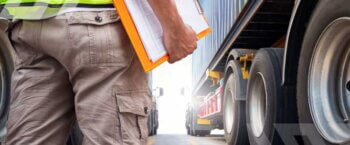Eight Pit Stops Along the Evolutionary Timeline of Trucking

Where would the trucking industry be today without the evolution of the truck itself? Below are eight groundbreaking moments along the timeline of the trucking industry.
- The first commercial truck is built by Gottlieb Diamler in 1896. They call it “Vehicle No.42.”
Capable of towing up to 3300 pounds with four horsepower and a two-cylinder motor, this truck starts it all. About 10 years later, Daimler introduces a 10-horsepower truck marketed towards farmers that boasts a seven mile-per-hour top speed. - The first 18-wheeler is invented by Alexander Winton in 1899.
Winton develops this vehicle to help transport the cars his company is selling across the country. - Mack, the largest truck manufacturing company in the world, is founded in 1900 in Brooklyn, NY.
Mack is the first company to use an automatic starter and make the hand crank obsolete. They become popular in the 1920’s and develop a reputation as a tough and dependable vehicle. - The first semi-trailer is invented in 1914 by August Fruehauf.
Primarily used to haul boats in the 1920’s and 30’s, the Fruehauf Trailer Company slowly becomes one of the largest trucking manufacturing companies in the U.S. and is still in business today (though under a different name). - The first consumer-focused pickup truck is produced in 1918 by Chevrolet.
Built off of their passenger car frame, this vehicle only provides a truck bed; its buyers need to install their own bed walls. Chevrolet doesn’t offer a completely assembled truck until 1931. - In 1925, Ford produces their Model-T Runabout with pickup body.
Ford provides the consumer-friendly option to add a bed to their Model-T’s. Two years later, their Model A’s go a step further by offering a steel cab and roll-up windows, which is considered a huge luxury. - In 1929, the Dodge Brothers create a ¾ ton pickup truck.
With the help of Chrysler, this becomes the standard for the trucks designed thereafter. - In 1939, Peterbilt is founded in Tacoma, WA.
Invented and designed to help haul logs, Peterbilt trucks effectively ended log drives (i.e. the use of rivers as the main way of transporting timber).
Over the last 80 years, the advancement of technology has allowed us to haul more weight further and faster than ever. New engine technology and fuel options continue to shape the industry. The future will see new manufacturers emerge, like Tesla and others, who will help reduce the strain on the environment, decrease cost-per-mile, and vastly improve safety and driver fatigue.
Get helpful content delivered to your inbox.
Sign up today.
Find high-quality loads fast, get higher rates on every haul, and access tools that make your job easier at every turn.






